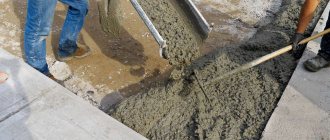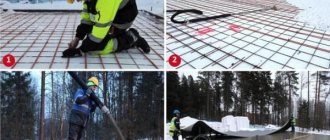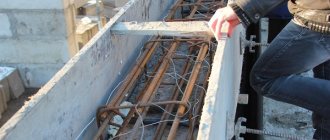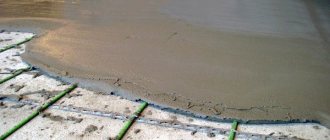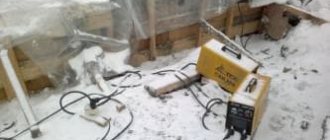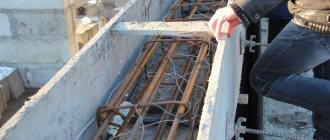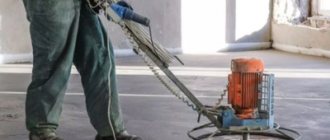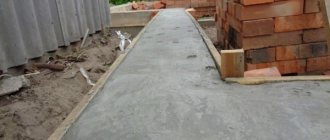Many builders who are just learning the basics of craftsmanship are of the opinion that after pouring the concrete solution into the formwork structure, the formwork stage follows, and after that all that remains is to enjoy the result of your creation. However, this is not entirely accurate. An important step is to care for the concrete after pouring the base.
Concrete protection
The main element of construction is the use of concrete structures and concrete surfaces. But having strength characteristics, it can lose its load-bearing capacity and other physical characteristics.
Hardened concrete
The loss of strength is affected by the insufficient resistance of concrete to environmental influences. It is advisable to design protection in order to determine the degree and duration of exposure. After this analysis, a method for protection is selected.
There is primary and secondary protection of concrete. In the first case, protective properties are achieved by creating a sand-cement stone that is resistant to the environment and selecting the most suitable cement composition for these conditions. Special additives are added to it to improve density, frost resistance, water resistance and crack resistance.
In the second case, protective properties are achieved by applying coatings to the surface. In this way, connection with the environment will be excluded or limited. These include protection from moisture and destruction.
Once the cement is laid, it must be protected from the ambient temperature.
Methods for caring for concrete mixture
The setting of cement is manifested by a chemical reaction that depends on the water in the cement-sand mixture. To ensure complete hydration of the cement, a certain volume of water is added to the mixture. The supply must either be maintained or replenished over the course of several days and weeks.
Therefore, caring for concrete after pouring consists of creating conditions that can stop evaporation. The active phase, during which stone is formed from a mixture of cement and sand, lasts about a month. During the first 15 days, concrete gains about 70-80% strength. If lost before this time, microcracks will appear on the surface and a significant reduction in strength will occur.
Concrete hardening
Evaporation can lead to dehydration of concrete. Which will lead to a slowdown or termination of the hardening process. The strength properties will decrease and cause cracking and shrinkage. Therefore, the main task is to provide the surface with normal temperature and moisture. The type, type of cement and local climatic conditions determine the method of maintenance. When hardening occurs, the volume changes. During rapid drying, shrinkage appears, then microcracks appear. In huge monolithic structures, large cracks appear during uneven heating in different parts.
If the air has a positive temperature of +15 ° C and humidity is more than 80% (water begins to penetrate slowly under such conditions), the hardening time becomes long.
When everything is moistened abundantly, the possibility of cracks is reduced. Maintenance work for slow-hardening cement lasts at least two weeks. And with Portland cement, at least a week. Humidification is done using a spray bottle. It is forbidden to water with a strong stream to avoid blurring the surface. The moist state is maintained by constant frequency of watering. After pouring, moisten after 10 hours, and in windy and hot weather after 2-2.5 hours.
Ways to keep the surface moist:
- Applying a protective composition to the surface of freshly laid concrete;
- Sprinkling with water using protective coatings;
- Aged with salts that absorb water.
When watering, the surfaces should be protected from drying out and in the interval between waterings it should be taken into account that:
Moisturizing concrete
- slow-hardening (low-heat) cement must be kept for more than two weeks;
- fast-hardening (alumina) is subjected to strong water saturation for the initial 8 hours, and then to a completely moistened state for 16 hours.
During humidification, its temperature decreases.
Features of filling in winter
When it’s frosty outside, it’s important to prevent the water in the prepared solution from freezing. For this purpose, special additives are used. They retain the thermal energy released during the hydration process in hardening concrete.
Scientists have found that when hardening, one cube of concrete releases heat, the volume of which is equal to 36,000 kcal. Half of this heat is lost in the first three days, the rest over the next seven days. If this process happens faster, the finished product loses its strength. Supplements help prevent unwanted effects from occurring. Their use allows pouring at temperatures below -15 °C.
But still, subsequent care is not canceled. Experienced builders use the following technologies to prevent freezing:
- A “warmhouse” or warm tent is built on top of the foundation or site, and a heat gun is placed inside. But practice shows that it is very difficult to control its operation (overdrying may occur). It is easier to prevent this by giving preference to infrared heaters. It is important to strictly maintain the distance between the heating lamp and the top layer of the structure. It must be at least 120 cm.
Warmhouse for concreting Source searchbiznes.ru
See also: Catalog of companies that specialize in the design, installation and repair of foundations.
- You can insulate the formwork itself by covering it with foam plastic or mineral wool. In this case, the concrete will heat itself. The method is justified when pouring is carried out in a zone of border temperatures.
- When it's below -20°C outside, construction work doesn't stop. The foundations are poured using a structure consisting of metal plates. Heating elements are installed in them, then formwork is assembled from them. The outer layer is additionally insulated. While the solution is setting, it is forcibly heated. After three or four days, the formwork is removed, and the foundation is covered from above with a tarpaulin or special thermomats. Under such a cocoon, the concrete finally cools down. This process is under the constant control of the foreman.
Concrete covered with thermomats Source prom.st
- Some builders heat up the newly mixed solution using electrical heating using powerful transformers. The measures are expensive, but completely justified: after all, if the foundation becomes covered with cracks, it will need to be redone. And this is an even bigger expense.
- If the solution is prepared without adding special additives, you need to use water that has been highly heated beforehand.
- It is important to carry out the laying continuously; if the top layer manages to freeze at low temperatures, the builders remove the ice with steam and immediately continue concreting.
Steam treatment of concrete Source monolitpro.info
There are cases when the use of combined methods is required. Often builders combine electrical heating and insulation of formwork. In such a situation, forced heating is carried out for two days, and then for another five, only external measures cope with the task. In this situation, concrete gains 80% of its strength within a week after pouring.
Care in warm temperatures
In warm weather, summer concrete care has certain features. Especially at temperatures above 28-30 ° C. As a result of scientific research, a graph has been calculated in which the strength gain depends on temperature. All you need is to maintain moisture on the surface and a temperature of about 24-25 degrees.
It is important to cover the entire top surface to prevent cracking due to evaporation. You can use any straw, burlap, sheet metal and other materials.
But there are often cases when maintaining a wet state is difficult and sometimes impossible. Sometimes it happens that the water can evaporate and leave behind the salts that were in it. They are deposited on the surface and begin to interact. As a result, the surface layer weakens. Therefore, it is recommended to cover the surface. Protective materials are placed 2 cm above the surface and watered with water. The material delays the passage of salt. The surface itself is moistened with steam. Therefore, caring for concrete in the summer should be based on certain principles.
Tips for warm temperatures:
Working with concrete
- Start it in the morning or evening when the temperature is lower than during the day.
- Provide protection from rays (film, slate sheets, roofing felt and other materials).
- Delivery of the mixture to the site within an hour and prompt installation.
- Watering during the first days. Watering begins after 8-10 hours.
- At a temperature of + 12 ° C and above, these works begin for three days every 3 hours during the day and once at night. This process takes up to 15 days.
- Please note that the water jet should be in the form of splashes.
- And care in the forty-degree heat involves watering the formwork and covering it with sawdust and other protective materials.
- Moisten the nodes and edges more thoroughly.
According to laboratory data, the strength will decrease by half when the temperature increases above 30 ° C, if it is not moistened.
Dust removal
At large industrial facilities, in public buildings, in garage complexes, in home workshops - everywhere they try to make the floor concrete. He is very practical. A properly executed screed does not absorb moisture. It has a solid base and a smooth, even surface. It is difficult to slip on it, and it is easy to care for. The only drawback is the formation of a large amount of dust. Over time, chips and traces of delamination appear on the front surface. And if the concrete floor is not properly cared for, even the most minor defects will become dangerous to human health.
Their appearance becomes possible for various reasons. And all of them are associated with intensive use of floors. Mechanical loads, chemical influences, non-compliance with laying technologies, incorrect concrete composition, low-quality components taken when mixing the solution - all this leads to the fact that even the strongest floor gradually begins to fail.
Dust on the surface of concrete Source janiclean.com
Concrete protection compounds
Various protective compounds are sprayed over the surface of the laid mixture. The following types are distinguished:
- colorless;
- painted white;
- black.
The colorless additive does not actually color the concrete. The white additive gives the mixture a white color. Chromaticity gives the same effect that is created when protecting. As a result, the surface temperature decreases.
The use of technology has led to the use of new protective compounds, with the help of which a transparent film is created on the surface. The research has not been completed and the technology assumes that the effect will be obtained at average temperatures and dry weather.
For coatings on airfields after laying the cement-sand mortar, various emulsions and resin solutions were used. They were used to cover surfaces to protect them from the sun and wind until it hardened. But the black color only increased the ability to absorb heat. Bituminous mastic also reacts. The use of bitumen mastic reduces the occurrence of cracks in low-sunny weather, but moisture will evaporate in the wind.
You can reduce heat absorption by using a white coating. And in all cases, the recommendations again include hydration.
Expert advice
To get a reliable design, experienced builders recommend the following:
- Upon completion of pouring the cement mortar, it is necessary to recheck the condition of the formwork. If there are defects, they can be eliminated within 2 hours before the hardening process begins;
- during hardening, the structure is protected from mechanical damage, pressure and sunlight;
- cracks that appear in plastic concrete can be eliminated by vibration;
- The surface should not be filled with water, but moistened in doses.
By following these tips, you can get a quality foundation for your home.
A homeowner who makes his own foundation must take into account all the nuances of its installation and maintenance at certain times of the year. Only by following clear recommendations can you make a high-quality base for the structure.
